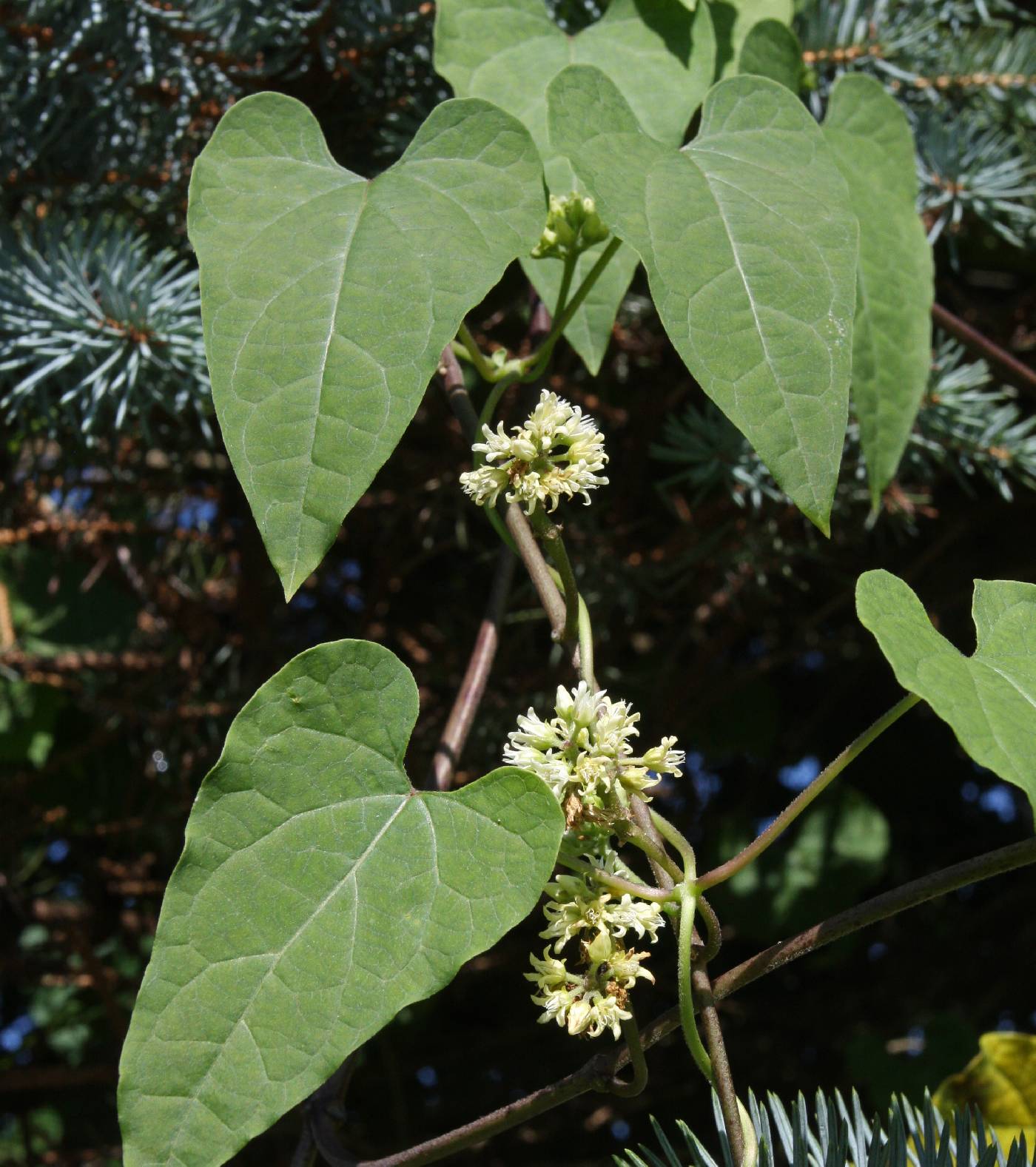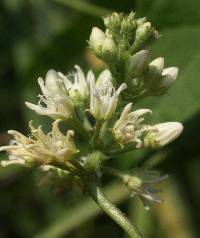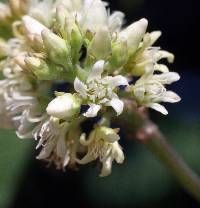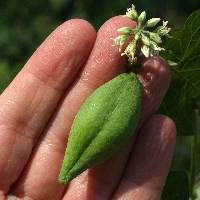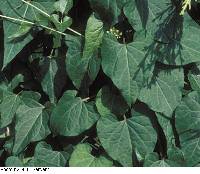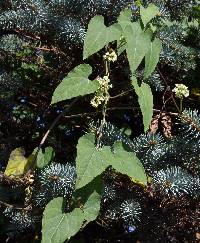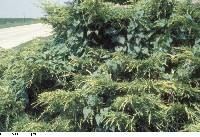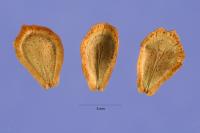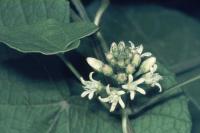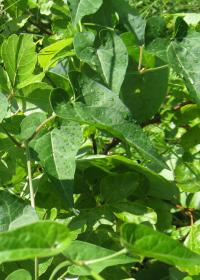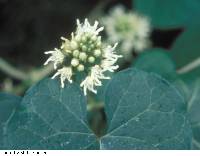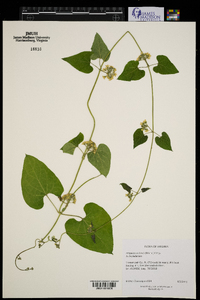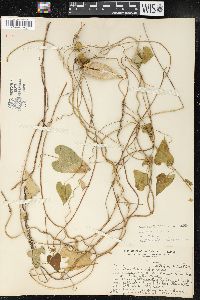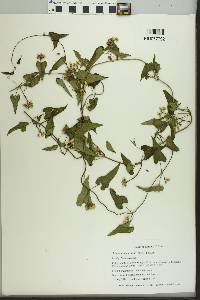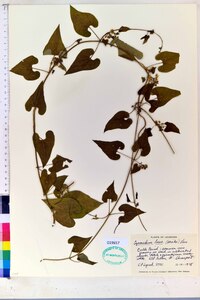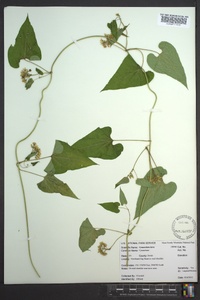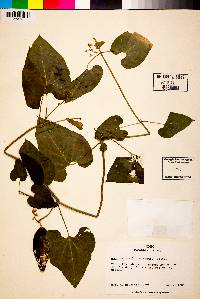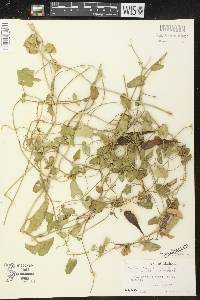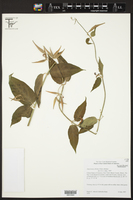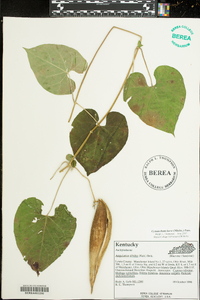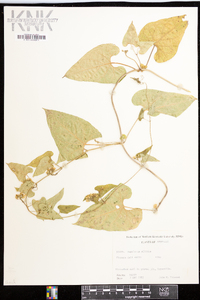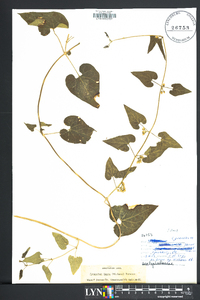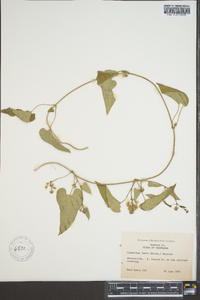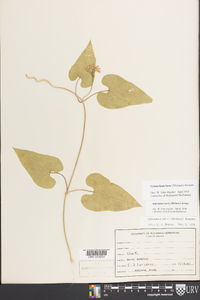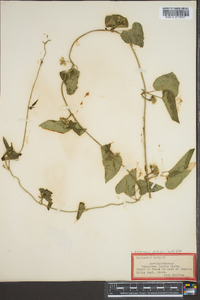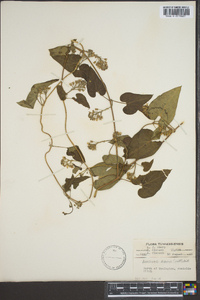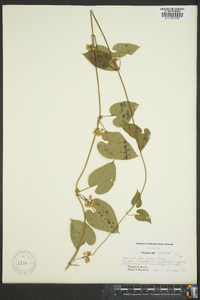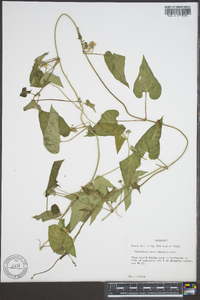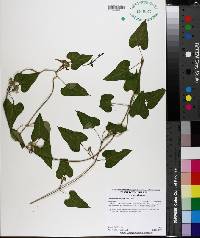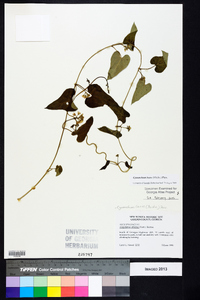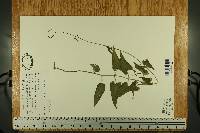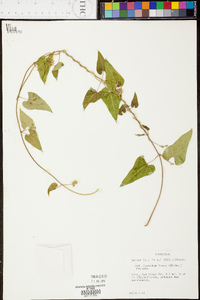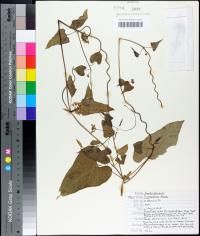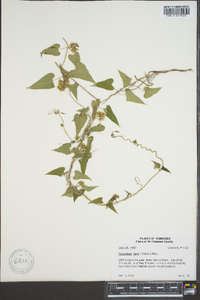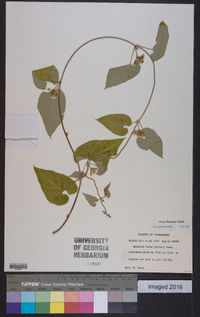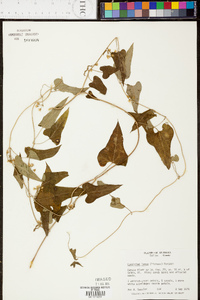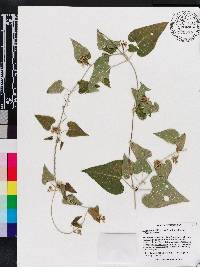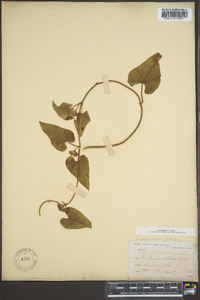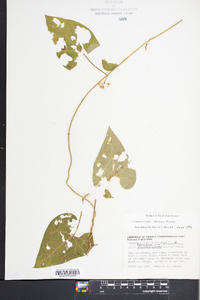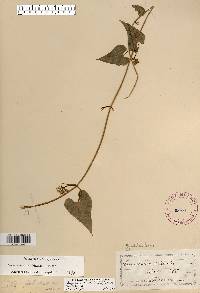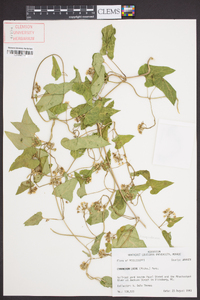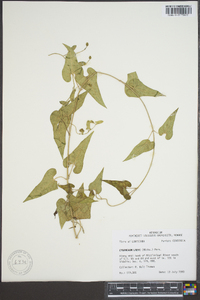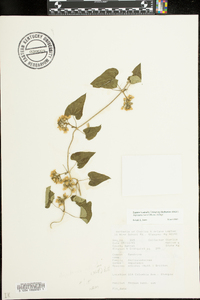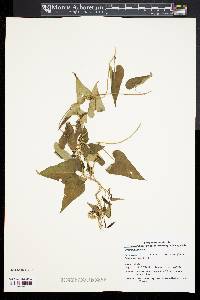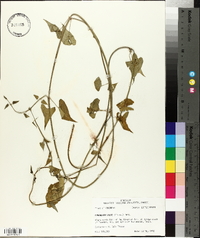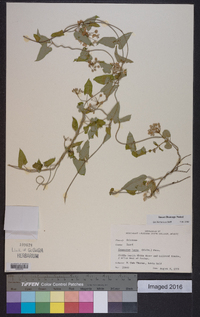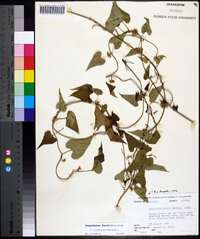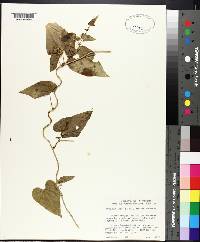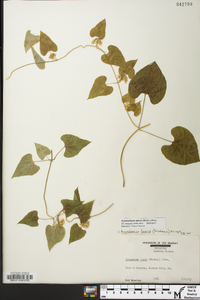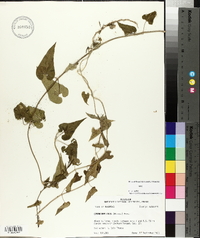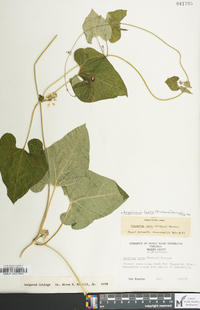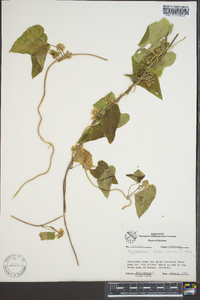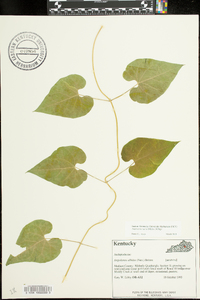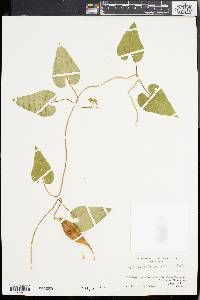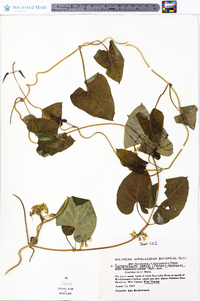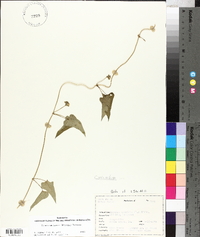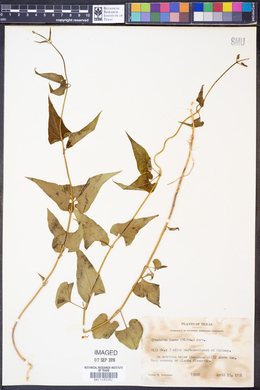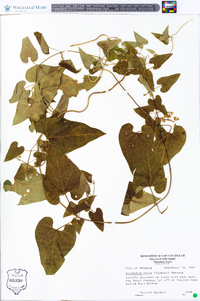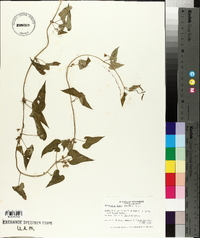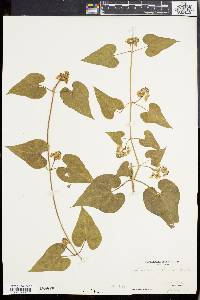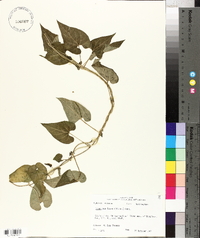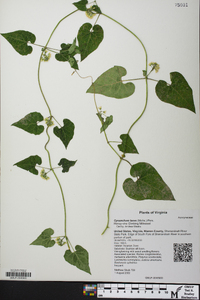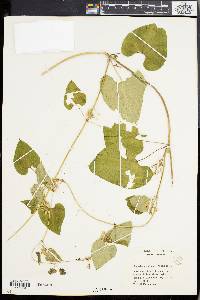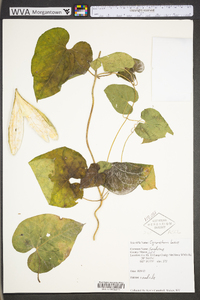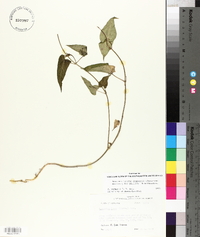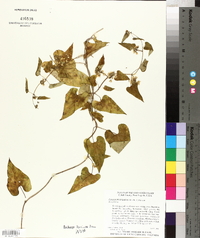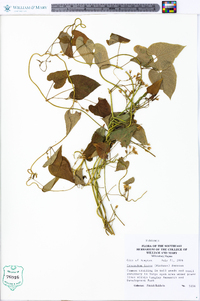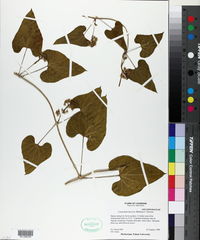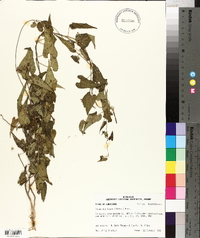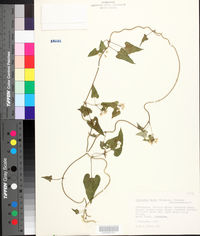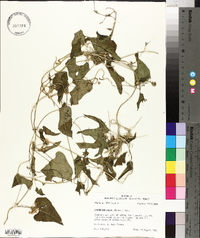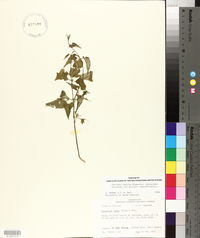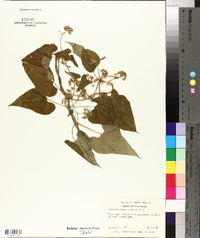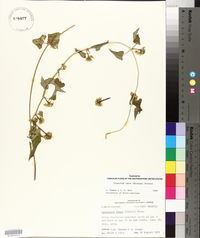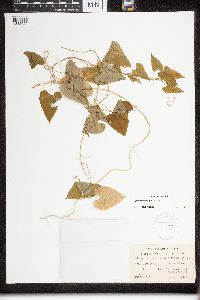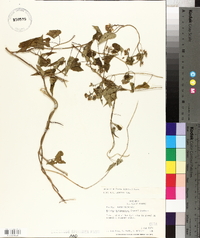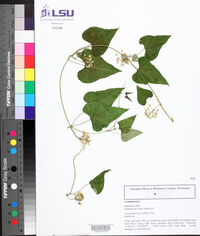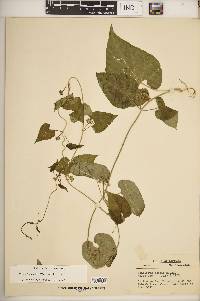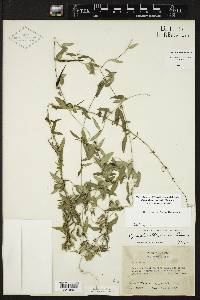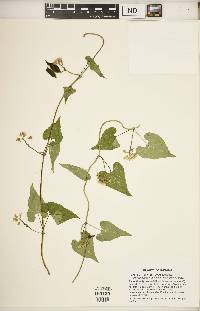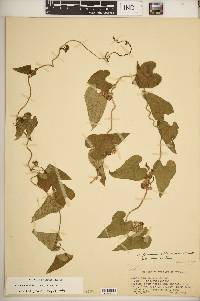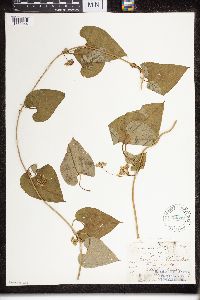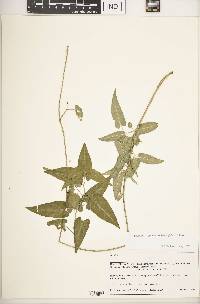
|
|
|
|
Family: Apocynaceae
Honeyvine
[Ampelamus albidus (Nutt.) Britton, moreAmpelamus laevis (Michx.) Krings, Gonolobus laevis Michx.] |
Perennial vine 2 - 10 m tall Stem: twining, climbing, herbaceous, green though sometimes reddish, mostly hairless. If the stem is broken or cut, it exudes milky sap (latex). Leaves: opposite, long-stalked (stalks up to 7 or 8 cm), non-toothed, usually hairless, 3 - 10 cm wide, up to 12 cm long, heart-shaped with a tapered, pointed or long-pointed tip, and a deeply cleft base with widely spaced, rounded lobes. Flowers: over twenty, in long-stalked (stalk up to 5 cm long, and hairy), axillary, umbel-like clusters with each flower on a hairy stalk up to 1 cm long. The small (5 - 7 mm tall), white, radially symmetric flowers have a whorl of extra appendages between the petals and stamens called a crown or corona. Sepals: five, spreading or ascending, often hairy. Petals: five, but fused at very base, then separating into erect or ascending, creamy or greenish-white, up to 3 mm wide, lance-shaped lobes with pointed tips. Stamens: five, but fused into a short sheath around the style, with the bases attached to both the petal tube and crown. The anthers are fused in a ring, attached to the stigma, and have prominent, membranous appendages at their tips. Pollen sacs (two per anther) each contain a single, hanging, oblong, waxy pollen-mass (pollinium). Pistil: with two, superior ovaries, each with one style, but then the styles uniting to form a common, thickened style-head at the top, with stigmatic regions along the sides and between the anthers. Fruit: a single-chambered, 10 - 15 cm long, slender, lance-shaped, smooth, hairless pod (follicle), which opens along a suture running down one side. Seeds: numerous, flattened, almost teardrop-shaped, and with a tuft of long silky hairs (coma). Similar species: Ampelamus laevis is the only species in this genus, but it can be confused with members of the genus Vincetoxicum. The only species from that genus in the Chicago Region, V. nigrum, differs by having more rounded or blunt leaf bases without large lobes, shorter leaf stalks (1 - 1.5 cm), smaller flower clusters on shorter stalks (only up to 1 cm long), and deep purple flowers. Superficially both of these species can resemble three twining species in the Polygonaceae family in the genus Fallopia (formerly lumped into the genus Polygonum in a wide sense), namely F. cilinodis, F. convolvulus, and F. scandens. However, all three of those species actually have alternate leaves (sometimes appearing opposite due to very short internodes), the plants (especially leaves) are usually hairy, the inflorescence is more elongate and loosely spike-like instead of umbel-like, there are only five total sepals and petals (namely tepals), the three outer tepals are winged or keeled and larger than the two inner tepals, there are three spreading styles, and the fruit are dark, hard, three-angled nutlets (achenes) enclosed within the enlarged tepals. Further, the stems of F. cilinodis have obviously fringed rings of tissue (ocrea) near the base of the leafstalks. If flowers are absent, A. laevis can resemble morning glories, which are members of the Convolvulaceae family, but members of that family have obviously alternate leaves, much larger and more showy flowers, fused petals, and separate stamens and pistils. Flowering: July to early September Habitat and ecology: Occasional, in cultivated fields, waste ground, or along railroads and roadsides. Occurence in the Chicago region: non-native Notes: This species was introduced from south of the Chicago Region. It is the only species in the genus (monotypic), though at times other sources have placed the species in the genus Cynanchum as C. laeve. However, members of the genus Cynanchum do not have such a conspicuous whorl of petal-like segments between the petals and stamens (crown or corona). Some people have also called this species Ampelamus albidus. This genus, as all members of the Asclepiadaceae family, is closely related to the Apocynaceae family, but in that family the pollen grains are not formed into discreet waxy masses (pollinia). Author: The Field Museum Subglabrous, climbing to 10 m; lvs long-petioled, acute or acuminate, deeply cordate-ovate, the rounded basal lobes separated by a broad sinus; infl umbelliform or shortly racemiform; cor 5-6 mm; its lobes creamy or greenish-white, the corona bright white; fr slender, lanceolate, smooth, 10-15 cm, low moist woods or fields, often weedy; Pa. to Ind., Mo., and e. Neb., s. to Ga. and Tex. July, Aug. (Cynanchum laeve; Gonolobus l.) Gleason, Henry A. & Cronquist, Arthur J. 1991. Manual of vascular plants of northeastern United States and adjacent Canada. lxxv + 910 pp. ©The New York Botanical Garden. All rights reserved. Used by permission. From Flora of Indiana (1940) by Charles C. Deam Mostly on the banks and alluvial plains of streams and in cultivated fields in southern Indiana. It is an obnoxious weed in corn and cultivated fields in the "bottoms." In 1938 County Agent Mervin F. Smith found it well established in a cornfield a mile south of Uniondale, Wells County. As a weed it is as difficult to eradicate as our common bindweed. The beekeepers widely publicized this plant as an excellent honey plant under the name of bluevine. We introduced it for this purpose at Bluffton and some seed escaped and we have been trying to exterminate it now for eight years without success. If the Indiana beekeepers responded to the appeal to plant this plant, it is, no doubt, now well established in all parts of the state. ...... Indiana Coefficient of Conservatism: C = null, non-native Wetland Indicator Status: FAC Diagnostic Traits: vine; leaves opposite, cordate-ovate, margins entire; inflorescences umbel-like, axillary; flowers white, radial, corona present; follicle fruits smooth, lanceoloid, 10-15 cm long. |
|
|
|

